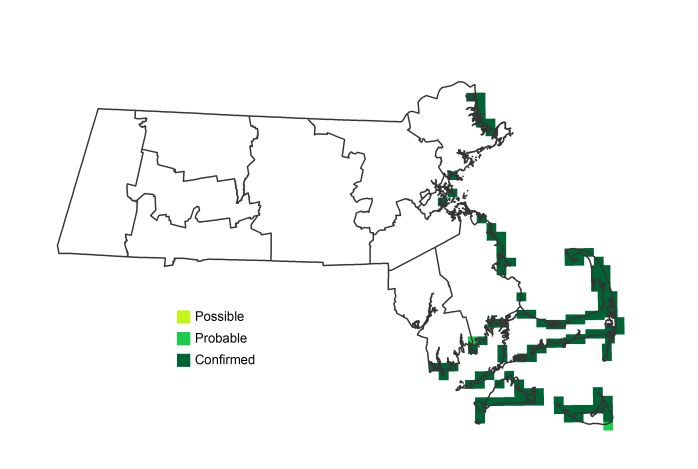Breeding Bird Atlases (BBA)
Find a Bird
Piping Plover
Charadrius melodus

Local and likely increasing
Action/monitoring needed
Threatened Species
“She had felt as if her heart were hiding down there, somewhere, with the quail and the plover and all the little wild things that crooned or buzzed in the sun.” – Willa Cather, O Pioneers!
The smaller of the two breeding plover species in Massachusetts is also by far the rarer. Tiny and sand colored, the Piping Plover could be tricky to locate in its beach habitat even where it used to be fairly abundant. A widespread decline has made this little shorebird a rallying point for conservation groups up and down the Atlantic coast. Thanks to the efforts of a large number of organizations and private citizens, Piping Plovers are still breeding in Massachusetts today.
Historic Status
The decline of the Piping Plover as a breeder in Massachusetts has been chronicled through the notations of several of America's great ornithologists. Alexander Wilson and Thomas Nuttall used words like “very abundant” and “common inhabitant” to describe the species during the first four decades of the nineteenth century. Thomas Mayo Brewer noticed the tide turning, however, when in 1884 he reported, “From very many of our most frequented beaches in New England and New Jersey this graceful and attractive species has been entirely driven; and in many others where a few still remain their wildness gives them, in all probability, their only chance for existence,” (Baird et al 1884). At that time hunters were legally and wantonly taking both adults and young, driving the species to near extirpation. Near the beginning of the twentieth century Edward Howe Forbush, then state ornithologist, initiated a stereopticon lecture tour around the state that ultimately led to increased awareness of all species, as well as legal protection for many of them, including the Piping Plover (Forbush 1909). In spite of this effort, the species’ hold on Massachusetts was tenuous.
Atlas 1 Distribution
The beleaguered Piping Plover continued to be under siege from increased predation due to rising gull populations and increased human use of its beach habitats during the 1900s, but by the time of Atlas 1 increased protection of the plover’s sensitive breeding areas was beginning to pay off. Piping Plovers bred at 6 beaches along the Coastal Plains, as well as at 1 site in the Boston Basin. The southern coast of the Bristol/Narragansett Lowlands also hosted a handful of active nesting pairs. Surpassing all of these regions, and accounting for over 80% of all occupied blocks in the state, was Cape Cod and the Islands. Evidence of breeding Piping Plovers in this region was found in 50 blocks throughout the state’s most-visited beach recreation region.
Atlas 2 Distribution and Change
Years of intensive monitoring, public education, and protection have helped the Piping Plover recover in Massachusetts, and currently this species stands as one of the great Atlantic Coast conservation success stories. Bay State Piping Plovers held their ground in 53 blocks, and expanded into 36 new ones, and it is estimated that Massachusetts now holds an impressive 38% of the east coast breeding population for this species.
Atlas 1 Map

Atlas 2 Map

Atlas Change Map

Ecoregion Data
Atlas 1 | Atlas 2 | Change | ||||||
Ecoregion | # Blocks | % Blocks | % of Range | # Blocks | % Blocks | % of Range | Change in # Blocks | Change in % Blocks |
Taconic Mountains | 0 | 0.0 | 0.0 | 0 | 0.0 | 0.0 | 0 | 0.0 |
Marble Valleys/Housatonic Valley | 0 | 0.0 | 0.0 | 0 | 0.0 | 0.0 | 0 | 0.0 |
Berkshire Highlands | 0 | 0.0 | 0.0 | 0 | 0.0 | 0.0 | 0 | 0.0 |
Lower Berkshire Hills | 0 | 0.0 | 0.0 | 0 | 0.0 | 0.0 | 0 | 0.0 |
Vermont Piedmont | 0 | 0.0 | 0.0 | 0 | 0.0 | 0.0 | 0 | 0.0 |
Berkshire Transition | 0 | 0.0 | 0.0 | 0 | 0.0 | 0.0 | 0 | 0.0 |
Connecticut River Valley | 0 | 0.0 | 0.0 | 0 | 0.0 | 0.0 | 0 | 0.0 |
Worcester Plateau | 0 | 0.0 | 0.0 | 0 | 0.0 | 0.0 | 0 | 0.0 |
Lower Worcester Plateau | 0 | 0.0 | 0.0 | 0 | 0.0 | 0.0 | 0 | 0.0 |
S. New England Coastal Plains and Hills | 7 | 2.6 | 11.3 | 15 | 5.3 | 14.2 | 5 | 2.2 |
Boston Basin | 1 | 1.8 | 1.6 | 3 | 5.4 | 2.8 | 1 | 1.8 |
Bristol and Narragansett Lowlands | 4 | 3.8 | 6.5 | 7 | 6.1 | 6.6 | 3 | 3.0 |
Cape Cod and Islands | 50 | 36.8 | 80.6 | 81 | 56.3 | 76.4 | 23 | 19.2 |
Statewide Total | 62 | 6.4 | 100.0 | 106 | 10.2 | 100.0 | 32 | 3.9 |
Notes
This persistence and expansion has helped increase their overall numbers, although it is unlikely that the Piping Plover would have been able to thrive so well without the extraordinary human assistance that it has received. This assistance has come from the US Endangered Species Act, from the strong commitments made by numerous state and private conservation organizations and the coastal towns of Massachusetts, and from the many beachgoers who have been willing to share their recreational space with these little plovers through the years. It should be noted, however, that continued challenges remain in the future for achieving complete recovery and population stability for this species. For instance, a review of the table of Piping Plover population estimates for the state (below) overlaid with the productivity (number of chicks fledged per nest), reveals reduced productivity over time for this species.




